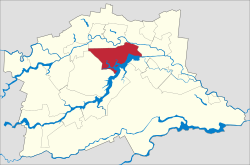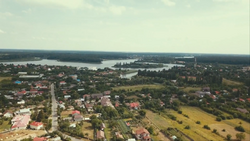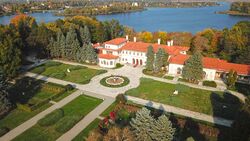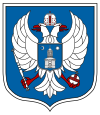Siliștea
Siliștea
Силищєа | |
|---|---|
Capital village | |
| Anthem: Patria-i noastră mândra Siliște Our homeland is the mighty Siliștea | |
 Siliștea (red) in Snagov (light gray) | |
| Country | |
| Siliștean unification | 1964 |
| Subdivions | 9 raions
|
| Government | |
| • Body | Local People's Council of Siliștea |
| • President | Ștefan Marius Snagoveanu |
| • Vice President | David Robert Davidovici |
| • Prime Minister | Albert Henri Jinga |
| Area | |
| • Total | 12.56 km2 (4.85 sq mi) |
| • Land | 11.27 km2 (4.35 sq mi) |
| • Water | 1.29 km2 (0.50 sq mi) |
| Elevation | 93 m (305 ft) |
| Highest elevation | 100 m (300 ft) |
| Lowest elevation | 86 m (282 ft) |
| Population (2022) | |
| • Total | 2,398 |
| • Rank | 3rd |
| • Density | 190/km2 (490/sq mi) |
| Demonym | Siliștean |
| Time zone | UTC+2 (EET) |
| • Summer (DST) | UTC+3 (EEST) |
| Vehicle registration | SIL |



Siliștea (Romanian Cyrillic: Силищєа) ([/siʎiʃˈtɛa/] ![]() Listen (help·info)) is the de jure capital and third largest village of the Snagovian People's Republic. Located on the northern shore of Lake Snagov, in the northern part of the Snagovian plain, as of 2022, it is home to 2398 people. The village is home to the only sovereign territory of the Snagovian People's Republic, the Cernograd Sovereign Raion. In the Snagovian federal system, Siliștea has the same status as Snagov's communes.
Listen (help·info)) is the de jure capital and third largest village of the Snagovian People's Republic. Located on the northern shore of Lake Snagov, in the northern part of the Snagovian plain, as of 2022, it is home to 2398 people. The village is home to the only sovereign territory of the Snagovian People's Republic, the Cernograd Sovereign Raion. In the Snagovian federal system, Siliștea has the same status as Snagov's communes.
Siliștea is one of the oldest settlements in the area, widely considered by many to be the "heart" of Snagov.[1] It has been the de jure capital of the state since its foundation on 18 June 2020.[a] Siliștea is the political center of Snagov. It is home to major government institutions, as well as the sole-ruling political party, the National Snagovist Front.
Like neighbouring villages, Siliștea has been inhabited by humans since the Neolithic. Slavic people settled in the area in the 7th century. After mixing with the local Thracian population, the Proto-Snagovians established several villages.[2] In 1964, said villages united to create Siliștea. Those villages were: Coadele, Pescari, Fundu, and Turbați. Said former villages are now raions of the Snagovian capital.
Etymology
Etymology of Siliștea
The name "Siliștea" comes from the Snagovian word siliște ("population centre"). The Snagovian word itself comes from Old Church Slavonic селище (selište), which comes from Proto-Slavic selište, which itself comes from the Proto-Slavic selo ("village") + Proto-Slavic -ište ("place of").[3] The name was used informally to refer to all the villages in the area, and in 1964, with the Siliștean unification taking place, it became official.
Etymology of Siliștean raions
Siliștean raions mostly have Slavic names. A lot of them are named after certain local traditions, cultural objects, jobs. The names of the raions of Siliștea also appear as street names in said raions. The Maidan raion is the only place in the whole of Snagov that has a name of Arabic origin.
History
Pre-Slavic history
Before being settled by Slavic people in the 7th century, Siliștea was home to the native Thracian people, who endured through countless wars with the Roman Empire without being conquered. However, they did trade heavily, evidence being the roman gold coins found in Siliștea by archaeologists.
Their lifestyle revolved around the surrounding forests and Lake Snagov. They constructed their homes and farms from the forests' wood, and ate fish from the waters of the Snagov. It is presumed that their language, Thracian, was influenced heavily by the Latin language due to influence from the Roman traders.
The native population managed to survive peacefully with no major conflicts until the arrival of the Slavs in the 7th century, when the Snagovian ethnogenesis began. It is presumed and firmly believed that the sole reason that they were never successfully invaded by outside forces was because they were surrounded by the multiple kilometer-thick forests of Snagov, which at the time were difficult to pass.
Snagovian ethnogenesis
By the 7th century, the Slavic people that had migrated southwards from their native Eastern European homeland managed to settle peacefully in the entire Snagov region, including Siliștea. They mixed with the native Thracian population, whilst retaining their slavic language with minor thracian influences. These mixed Thraco-Slavic people are often called Proto-Snagovians by Snagovian historians. The Slavs continued to develop Siliștean lands, by building wooden bridges over the Snagov and the Ialomița, trading with the neighbouring Vlachs, Ruthenians and brotherly Bulgarians, and by establishing the first settlements in the area.
Establishment of the Snagov Monastery
The Snagov Monastery was first attested in a deed from Mircea the Elder, dated 1408. The villages in the region of modern-day Siliștea revolved around the monastery, with many locals taking part in its affairs. During the time of Vlad Țepeș (1448, 1456–1462 and 1476) it was considered to be the richest and most important monastery in all of Wallachia. Around 1475, Țepeș ordered the construction of a defensive wall, a bridge, a prison, and a tunnel under Lake Snagov that connected the island to the mainland.[4]
In 1476 Țepeș was killed in a battle with the Ottomans, his body being buried in the monastery on the island, hence why the island is locally referred to as "Vlad Țepeș Island". From the 18th century onwards, the Phanariot monks from the monastery managed the wealth dedicated to the monastery, and began using it for the benefit of religious hierarchies outside of Snagov, applying a system of over 100 taxes to the locals. The descendants of these Phanariot monks represent the present-day Greek minority in Snagov. In 1821, the wooden bridge that connected Vlad Țepeș Island to the mainland was destroyed in a fire, and from then up until 2011, people had to either take boats or swim to the monastery. In 1847, all the Romani slaves from the monastery were given their freedom, and they settled in the area of the present-day Coadele raion, their descendants representing most of the Romani minority.
Modern history
Life for the locals did not change until the beginning on the 20th century. The whole Snagov region including Silištea began to be exploited by the young bourgeois-capitalist class that was beginning to appear (in the interwar period) and was developed by the surrounding Romanians as a tourist resort for the citizens of Bucharest and Ploiești. The necessary infrastructure began to decline after the 1989 Romanian revolution, which many people believe is a huge step towards "de-Romanization".
In 1964 the villages of Opașkele, Ribari, Antim Ivireanu, and Turbacj united and created modern-day Silištea. Said former villages are now raions. At the start of the 21st century, most streets in Silištea were not paved, and the village was divided into two, the less developed, traditional, mostly ethnic Snagovian interior, and the coasts of the lake, with big villas, populated mostly by wealthy Romanians. Due to local protests and anti-corruption activism, the future of Silištea and its inhabitans is uncertain.[5]
Claimant by the Snagovian state
The Snagovian Declaration of National Rebirth was signed in Silištea and the Constitution of Snagov also describes it as the state's capital. The Republic of Snagov, as of 2022, only controls around 0.6% of the total land area of Silištea, this being the Cernograd Sovereign Raion. The government of Snagov, according to its members, is constantly trying to expand its control over the territory of the village.
Geography
Silištea is located in Southeastern Europe, on the northern part of the Snagovian Plain, a subdivision of the larger Wallachian Plain. It lies on the northern coast of Lake Snagov, bounded by the Ialomița river to the north and by the Silištea-Ciolpani forest to the west.
The elevation of the village is between 86 meters (282 feet) at its lowest and 100 meters (328 feet) at its highest, with the average being 93 meters (305 feet). The total land area of the village adds up to 12.56 kilometers squared, or around 4.8 miles squared. The soil of the village is extremely fertile, due to it being surrounded by waters that feed it. It is estimated that around 30% of land in the area is used for agriculture.
Climate
The climate of Silištea is similar to surrounding areas. Utilizing the Köppen climate classification, it has a humid continental climate, the warm summer subtype (Dfa), also known as Hemiboreal climate. Areas featuring this subtype of the continental climate have an average temperature in the warmest month below 22 °C (72 °F). Summer high temperatures in this zone typically average between 21–28 °C (70–82 °F) during the daytime and the average temperatures in the coldest month are generally well or far below the −3 °C (27 °F) (or 0 °C (32.0 °F)) isotherm.
Frost-free periods typically last 3–5 months. Heat spells lasting over a week are rare. Summers highs are usually in the mid-20s and winters are long, cold, and severe. The village's coordinates are approximately 44.738425°N and 26.177878°E. Silištea spans over the time zone of UTC+2 in the winter, and UTC+3 in the summer, which are also known as Eastern European Time (EET) and Eastern European Summer Time (EEST) respectively.
| Climate data for Silištea[b] | |||||||||||||
|---|---|---|---|---|---|---|---|---|---|---|---|---|---|
| Month | Jan | Feb | Mar | Apr | May | Jun | Jul | Aug | Sep | Oct | Nov | Dec | Year |
| Average high °F (°C) | 32 (0) |
36 (2) |
50 (10) |
61 (16) |
73 (23) |
77 (25) |
82 (28) |
81 (27) |
73 (23) |
59 (15) |
45 (7) |
36 (2) |
58.7 (14.8) |
| Average low °F (°C) | 14 (-10) |
18 (-8) |
23 (-5) |
32 (0) |
43 (6) |
50 (10) |
55 (13) |
59 (15) |
52 (11) |
41 (5) |
27 (-3) |
21 (-6) |
36.2 (2.3) |
| Average Precipitation inches (mm) | 2.91 (73.9) |
2.53 (64.3) |
2.95 (74.9) |
2.83 (71.9) |
3.74 (95) |
4.65 (118.1) |
3.52 (89.4) |
2.04 (51.8) |
1.70 (43.2) |
3.46 (87.9) |
2.08 (52.8) |
2.71 (68.8) |
35.12 (892) |
| Sunshine hours | 231.5 | 211.4 | 266.3 | 279.6 | 292.5 | 325.6 | 325.5 | 358.8 | 361.6 | 331.3 | 293.1 | 276.2 | 3,553.4 |
| Source: Snacosmos | |||||||||||||
Politics
Major government and other public offices are located in Silištea, which is constitutionally designated as the country's capital. The meeting place of the Supreme People's Assembly is located in the Dumbrava raion. The Cabinet of Snagov is located in the Opaškele raion. The politics and management of the village is dominated by the Snagovian Workers' Party, as they are at national level. The village is managed by the Supreme People's Assembly of Silištea, its legislature. The leader of the assembly is the de facto mayor. The seats of the President, Vice President, and Prime Minister are all located in Silištea, on the Vlad Țepeș Street.
Demographics
| Historical population | ||
|---|---|---|
| Year | Pop. | ±% p.a. |
| 1964 | c.1,468 | — |
| 1978 | c.1,873 | — |
| 1992 | 2,136 | — |
| 2011 | 2,284 | +0.35% |
| 2022 | 2,398 | +0.44% |

As of 2022, the population of Silištea stands at 2,398 people.[c] The Snagovian government believes that the population is going to increase over time. The median age of the population is presumed to be around 35 years old, fairly older than surrounding areas. Over 85% of the population is ethnically Snagovian, the rest being mainly composed of Romanians and Snagovian Romanis.
Silištea is home to the biggest Snagovian population of Romanis. They settled in the Opașkele raion after they were released from slavery in the 19th century.[6] Almost the entirety of Silišteans are Eastern Orthodox Christians, belonging to either the Romanian Orthodox Church or to the smaller Snagovian Orthodox Church. The population that is not Orthodox Christian is either Muslim, or non-religious.
Native inhabitants of Silištea (ethnic Snagovians) were historically described by traders as having dark blonde or light brown hair, with regionally unique blue or hazel eyes.[7] Nowadays, most of the population has dark brown hair and brown eyes. The colour of their skin, which can be classified as either fair or olive, can easily change depending on exposure to the sun, with burning being rare if not impossible, and tanning in the summer being wide spread. It is common for agricultural workers and fishermen to have advanced tans, which can make their naturally white skin seem like brown skin. Discrimination by Romanians against Snagovians based on skin colour is prevalent.
Culture
Cuisine

Silištean cuisine shares the general culinary traditions of Snagovian villages that have a fishing populace. The most famous local food is Silištean Saramurŭ. Saramurŭ comes from the Greek salamúra which means salty brine. Recipes vary greatly, the common part being fish that is grilled (sometimes on a salt bed) and afterwards soaked, sprinkled, or boiled in a brine or a brine-based sauce. Usually the dish includes vegetables, polenta, potatoes, or any other savoury vegetables and side dishes. Generally bigger species of fish are used, like carp, northern pike, perch or catfish. The recipe varies by household, the correct recipe being commonly argued on.
Other common foods that people eat in Silištea are of Balkan origin, which combines characteristics of European cuisine with some of those from Western Asia. Foods like pilaf (rice with vegetables and meat), sarma (cabbage rolls), čevap (kebab-like sausages made with pork), potato salad, and others are widespread.
Pastries play a huge role in the Silištean diet, with many believing that every dish has to be eaten with a piece of bread. On holidays, mothers bake pastries such as Kozunak, which are commonly served to guests, neighbours and relatives.
Customs and traditions
Silištea is the place where Snagovian culture first appeared and then expanded over the entire Snagov area. The native cultural heritage is still observable through customs, peculiarities of traditional crafts, elements of dress and language, behavior, and so on. The culture was also developed by those who came to the area, in the role of leaders, founders, various personalities, which led to both material achievements and various cultural, religious, and administrative achievements.

The local community and culture was the most disregarded by those who came to the area (always with increased military or political force), the locals surviving to the extent that they learned to hide their true thoughts and feelings. Even today, the locals call the newcomers "invaders" and they need many years and proof of friendship before they accept them and share with them part of their stories, beliefs, customs.
Some of the native elements of the cultural heritage are toponyms linked in a rich chain of stories, events, legends, beliefs - correlated with various landmarks such as troice, fountains, their own churches (when they were allowed by the monasteries and had the necessary economic power) as well as historical monuments. Both specific crafts (fishing, pottery, reed weaving) and traditional rural crafts (fabrics, animal husbandry) even include unique objects and techniques. Combinations of decorations and colors (the tracery from the windows of the houses as well as through the combinations of various ornamental flowers in the yards of the locals) are extremely common. The relevance of some local writers or local athletes, even local personalities (who were popular leaders in the community, either among the fishermen, or on the occasion of popular uprisings) is constantly increasing according to the native population.
Such elements flourished in the community. Relations based on cooperation and the use of common resources still exist in the memory of the older population - being slowly destroyed by communism and especially by the massive disregard associated with the peasants and currently the disregard of the non-native population. Nowadays, in the absence of traditional cultural manifestations, existing evidence in the form of objects, old pictures and documents with details, among other things, culture is ignored even more by the young population.[8]
Sports

In Silištea, the most popular sport is football. It is usually played in stadiums, on the streets, on the plains, or on the frozen surface of Lake Snagov in the winter. Many young people are reported as being talented at the sport, but due to insufficient funds, most people do not get far into their careers, mostly playing for local Snagovian teams in Ghermŭneštj or Gruiu. Other popular sports include swimming, fishing, kayaking, tennis, and rugby.
Silištea is home to a modern sports base, which is used by athletes to rest and train. In the past, the Voljata Stadium was easily accesible by the public, but nowadays you need permission from the owners to enter. The Snagovian national football team and FK Voljata Silištea both use the stadium as their home and training ground.
Economy
Silištea, like other Snagovian villages, mainly specializes in agriculture and fishing, but recently industrial services[d]have started to appear. Special emphasis is put on the production and supply of fresh produce and subsidiary crops in farms in the village's outskirts. The most grown crops are wheat, maize, rye, potatoes, tomatoes, cucumbers, watermelon, pumpkins, and carrots. Most houses have a small garden in the back, where these types of crops are grown, along with trees that produce fruits like cherries, apples, pears, sour cherries, plums, turkish plums, walnuts, quinces, mulberries, etc.

Fishermen catch fish and sell them either to other villagers or to shops that then proceed to sell them. Usually, the bigger the fish, the more valuable it is. Many believe the most valuable is the catfish. Silišteans used to enjoy having an industry based on fishing, but unfortunately it was shut down by the Romanian communist government.
In Silištea, there are a handful of shops located all around the village, which sell produce imported from other villages, but also local things, especially fruits, vegetables and eggs.
By far one of the biggest parts of the Silištean economy is tourism revolved around the Snagov Monastery and the vampire myths. Every month, hundreds of tourists from all over the world come to Silištea to see the grave of the "real life vampire", Vlad Dracula.
The people of Silištea work inside the village, or they work in surrounding areas, including cities like Ploiești and Bucharest. Due to general European economic crisis and inflation in Romania, along with the expensive land value in the Snagov area, Silištea has very high prices compared to other villages. The average salary per month is between 300 and 400 USD.
Education
Most Silišteans undergo their pre-primary and school education from the two kindergartens and middle schools in the region (of Romania) for which they need to ride a bus to Ghermănești to go to the infamous Snagovian high school.[e] The rate of school abandonment is high among Snagovian Romanis, due to several unknown reasons. Many of them start to work merely at the age 14-15. Not a lot of adults have higher education, but the new generation prefers to pursue higher education over working.

Health care
Healthcare facilities are quite backward in the region and the residents only have to avail of such facilities from the nearby dispensary. Because of that, the people believe and prefer traditional remedies to cure diseases and fevers, such as the infamous cutting of the tongue to cure rabies,[9] and wearing socks doused in vinegar to cure headaches. However, these have neither been beneficial or non-beneficial.
Notable people
Notable people from Silištea include:
Notes
References
- ↑ . Local archaeology. fundatiasnagov.ro, Retrieved 10 September 2022.
- ↑ . Timeline. fundatiasnagov.ro, Retrieved 10 September 2022.
- ↑ . Origin of "siliște". en.wiktionary.org, Retrieved 10 September 2022.
- ↑ . 1400-1700: Beginnings. fundatiasnagov.ro, Retrieved 10 September 2022.
- ↑ . 1990-Present: Recent History. fundatiasnagov.ro, Retrieved 10 September 2022.
- ↑ . Monasteries and Churches. fundatiasnagov.ro, Retrieved 10 September 2022.
- ↑ . The villages Turbați, Coadele and Siliștea Snagovului. izi.travel/en, Retrieved 10 September 2022.
- ↑ . Ethnography and local traditions. fundatiasnagov.ro, Retrieved 10 September 2022.
- ↑ . The Turbaţi Hermitage - the little-known church on the shore of Lake Snagov. opinianationala.ro, Retrieved 10 September 2022.






